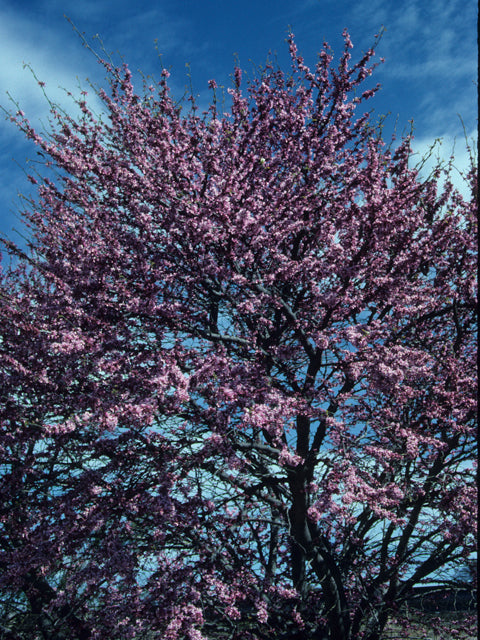Texas Redbud (Cercis canadensis var. texensis)
Texas Redbud (Cercis canadensis var. texensis)
Low stock: 2 left
Couldn't load pickup availability
Cercis canadensis L. var. texensis (S. Watson) M. Hopkins
Texas Redbud
Fabaceae (Pea Family)
Synonym(s): Cercis canadensis ssp. texensis, Cercis occidentalis
USDA Symbol: CECAT
This Cercis canadensis variety is a large shrub or small tree, 10-20 ft. in height, differing from the more easterly Eastern redbud (Cercis canadensis var. canadensis) in having smaller, more glossy, and usually hairier leaves with wavy edges, more of a tendency to have red seedpods, and a smaller stature. With a natural range extending from the mountains of southern Oklahoma through the limestone spine of central Texas south to northeastern Mexico, it is also more drought-tolerant than Eastern redbud, though less so than the smaller, more western Mexican redbud (Cercis canadensis var. mexicana). Like all Cercis canadensis varieties, its clusters of flowers appear in early spring before the leaves emerge and continue to bloom as the leaves develop. Leaves are heart shaped to kidney shaped, rounded at the tip, slightly wavy on the edges, and glossy, often with some hairiness on the underside. Flowers rose purple, in small clusters along the branches, appearing before the leaves, in March or early April. Fruit a flat, reddish brown pod up to 4 inches long and pointed at the tip. Deciduous leaves turn gold or red in fall. Seedpods are reddish purple and persist into the winter.
The redbuds of eastern North America have long been popular for their pink-purple early spring flowers that appear on bare wood before the leaves emerge. Texas redbud is the appropriate variety to use if you live on limestone soils from southern Oklahoma through central Texas to northeastern Mexico. It is drought-tolerant within its range, prefers dappled shade but is also found in full sun, and can do well even on relatively thin soils. Its glossy, rounded leaves bring welcome shade and its flowers attract pollinators.
Plant Characteristics
Duration: Perennial
Habit: Tree
Leaf Retention: Deciduous
Leaf Arrangement: Alternate
Leaf Complexity: Simple
Leaf Shape: Cordate , Ovate , Reniform
Leaf Venation: Palmate
Leaf Margin: Entire
Leaf Apex: Acute , Obtuse
Leaf Texture: Leathery
Breeding System: Flowers Unisexual , Monoecious
Fruit Type: Legume
Size Notes: Up to about 20 feet tall.
Leaf: Dark Green
Flower: Flowers 1/3-2/5 in. long
Fruit: Green to red or purplish red to reddish brown pods 2-4 in. long pod, about 1/2 in. wide or less, tapering at both ends, flat with several seeds 1/6-1/5 in. long.
Bloom Information
Bloom Color: White , Pink , Purple
Bloom Time: Mar , Apr
Bloom Notes: Color normally pink or purple, rarely white. White-flowered cultivars have been developed.
Distribution
USA: OK , TX
Native Distribution: Southern Oklahoma south through central Texas to Nuevo Leon in Mexico
Native Habitat: Dry slopes of canyons & foothills below 4500 ft. Edwards Plateau and limestone soils of north central Texas and eastern part of Plains Country.
Growing Conditions
Water Use: Low , Medium
Light Requirement: Sun , Part Shade
Soil Moisture: Dry
Soil pH: Alkaline (pH>7.2)
CaCO3 Tolerance: Low
Drought Tolerance: Medium , High
Cold Tolerant: yes
Heat Tolerant: yes
Soil Description: Well-drained, calcareous, rocky, sandy, loamy, or clay soils, usually limestone-based.
Conditions Comments: Drought- and cold-tolerant within its range. Give dappled shade when young. A selection called 'Sanderson' is said to be the most drought-adapted Texas redbud cultivar.
Benefit
Use Ornamental: Showy, attractive, understory tree or accent tree.
Use Wildlife: The nectar is sought after by butterflies, bees, moths, and insects. The leaves are sometimes browsed by deer. The seeds are eaten by granivorous birds.
Use Food: The flowers are fried in Mexico. The flowers are acid and are sometimes pickled for salads. The nectar is of some value as a source of honey.
Use Medicinal: A fluid extract can be taken from the bark which is an active astringent used in the treatment of dysentery.
Conspicuous Flowers: yes
Interesting Foliage: yes
Attracts: Butterflies
Larval Host: Henry's Elfin butterfly
Nectar Source: yes
Deer Resistant: Moderate
Value to Beneficial Insects
Special Value to Native Bees
Special Value to Bumble Bees
Provides Nesting Materials/Structure for Native Bees
Image Information
Photographer: Wasowski, Sally and AndyAccession date: 2006-06-13
Filename: SAW_00827.JPG
Slide Index: W02326
Restrictions: Unrestricted
Collection: Wasowski Collection
Original Format: 35 MM
Orientation: Portrait
Shot: Whole Plant(s)
NPIN Image Id: 21881


